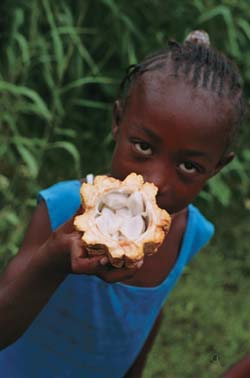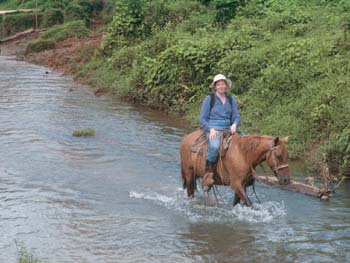 |
 |
| current issue |  |
past issues |  |
send a letter/news |  |
address update |  |
advertise |  |
about us |  |
alumni home |
Features
Planting HopeFlorence Reed '90 is saving the rainforest by helping the people who live in its shadow
by Suki Casanave '86G
Also read: Building a Sustainable Life
 A mother and daughter with their first harvest of
cocoa beans in Bella Florida, Panama.
A mother and daughter with their first harvest of
cocoa beans in Bella Florida, Panama.
|
In the hillside fields of northern Honduras, machetes are at work—swinging and chopping, swinging and chopping—beating a steady cadence in the still, tropical air. Cicadas drone. A howler monkey bellows in the distance. And all day long, machetes hack through the fields, back and forth, back and forth. Making a living from the soil has never been easy here. Most farmers are too poor to buy tools. But everyone owns a machete. These long narrow blades are used to harvest crops, to chop trees and to fight the tropical undergrowth that creeps relentlessly into the fields. Side by side, young boys and old men work in the sweltering heat, bent and swinging.
It has been this way for generations. A farmer clears a few acres of rainforest and plants corn and beans, growing just enough to feed his family. Each year, yields are a little smaller, the soil more depleted. After a few years, the family moves on, leaving behind a moonscape of barren soil. Then the process begins again, slashing and burning a new piece of rainforest to create another field. In some cases, families simply give up on farming and move to the city in hopes of finding a job. Here, where their farming skills are useless, they discover instead a new kind of poverty.
 Children in Panama show off organically grown cucumbers, one of about 42 crops grown on a Sustainable Harvest-participating farm that once depended almost exclusively on coffee.
Children in Panama show off organically grown cucumbers, one of about 42 crops grown on a Sustainable Harvest-participating farm that once depended almost exclusively on coffee.
|
 A child holds a cacao seed pod, a cash crop grown by Sustainable Harvest-participant farmers in southern Belize.
A child holds a cacao seed pod, a cash crop grown by Sustainable Harvest-participant farmers in southern Belize.
|
"I saw the rainforest destruction—and the poverty—with my own eyes," says Florence Reed '90, who joined the Peace Corps as soon as she graduated, and was stationed in Central America. Here, where more than half the rainforest has been destroyed in the last 50 years, Reed drew on her degree in environmental conservation, as well as on her own extensive research, to teach sustainable farming methods to villagers in Santa Rita, Panama. So many trees had been cut in their village that the topsoil had been completely washed away. The exposed ground had become so parched and hard it could no longer absorb moisture, and the water supply was in danger. "They were begging for help," she says.
 In Nicaragua, Florence Reed '90 travels eight hours by horse or mule to reach farming communities.
In Nicaragua, Florence Reed '90 travels eight hours by horse or mule to reach farming communities.
|
What Reed witnessed in that small village sparked a determination to devote her life to saving the rainforest. So she went in search of a job with an organization that shared her goals. What she found was discouraging. Some groups offered workshops or conferences and then left. Others bought acreage and called it a park. Neither worked: farmers would still cut and burn trees to clear fields for planting. One agency she heard about paid people to plant millions of trees on a mountainside in an effort to promote reforestation. "Within a couple of years the trees had all been cut down—by the same people who had planted them," says Reed. "They had no reason to value what they'd done, no understanding of the process."
Reed envisioned an organization that would work alongside farmers, helping them learn to coexist with the rainforest instead of destroying it. She would follow up with visits for at least three years until the new way of farming became more natural than the old way, until farmers saw the changes that were possible—a better life and a thriving rainforest. For a few years, as she worked with various nonprofits and traveled periodically to visit farmer friends in Central America, Reed continued to dream, sharing her idea with anyone who would listen. And then one day a $6,000 check arrived in the mail. Sent by a Swiss acquaintance she'd met during a trip to Central America, the donation was the first tangible evidence that her dream had a future.
Page: 1 2 3 Next >Easy to print version
blog comments powered by Disqus

